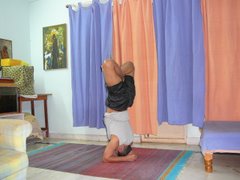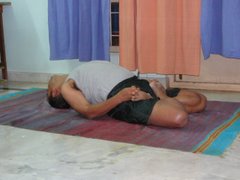Sanmukha Baddha Hasta Seershasana
Sanmukha (n.) = front
Baddha (adj.) = closed, interlocked
Hasta (n.) = hand, arm
Seersha (n.) = Head, top
Asana = posture
Here, in this Asana, the arms are inter-locked to the front of the head.
Below is given a close-up of the interlock structure of the arms, for a better understanding of how the arms are during the Asana.
Breathing: As usual, breathe in while raising the legs up in the air. Breathe deeply and slowly while holding the position. Hold the position for at least 5 breaths. My one slow breathing cycle takes approximately 15 seconds - of course it varies from person to person, as also it varies in my case too - As I am developing in the way of Yoga, my breathing cycle is getting longer.
Wednesday, January 30, 2008
Monday, January 28, 2008
Mukta Hasta Seershasana
Mukta Hasta Seershasana - Variation 0
This is the plain vanilla version of the Mukta Hasta Seeshasana. The other variations of Mukta Hasta provided earlier were the real variation.
Actually this is the version I had learnt first in the childhood days, even before the Baddha Hasta version and variations. Pretty easy stuff when you are trying it against a wall - that's what I did in the childhood days. hehe!
This is the plain vanilla version of the Mukta Hasta Seeshasana. The other variations of Mukta Hasta provided earlier were the real variation.
Actually this is the version I had learnt first in the childhood days, even before the Baddha Hasta version and variations. Pretty easy stuff when you are trying it against a wall - that's what I did in the childhood days. hehe!
Wednesday, January 23, 2008
Prasarita Mukta-Hasta Sirshasana
Prasarita Mukta-Hasta Sirshasana - Variariation 3
Prasarita (adj.) = extended
Pra is a prefix equivalent to latin con which is = with
Saran (n.)/(v.) = displacement by a distance (from physics, where displacement/time = speed)
Prasaran (n.)/(v.) = with displacement, hence Prasarita the adjective form means extended.
This variation of Sirshasana is slightly more challenging than the normal tripod, where the hands are closer to the head. It is quite challenging however, to move into Seershasana with your hands in the Prasarita position.
Breathing: as usual, breathe in while striking the pose. and breathe normally as you hold the pose.
Drishti: Nasagre
Prasarita (adj.) = extended
Pra is a prefix equivalent to latin con which is = with
Saran (n.)/(v.) = displacement by a distance (from physics, where displacement/time = speed)
Prasaran (n.)/(v.) = with displacement, hence Prasarita the adjective form means extended.
This variation of Sirshasana is slightly more challenging than the normal tripod, where the hands are closer to the head. It is quite challenging however, to move into Seershasana with your hands in the Prasarita position.
Breathing: as usual, breathe in while striking the pose. and breathe normally as you hold the pose.
Drishti: Nasagre
Monday, January 21, 2008
Mukta Hasta Sirshasana - Variation 2
Mukta Hasta Sirshasana - Karaprishtha variation
Kara (n.) = palm
prishtha (n.) = back
This is the back of the palm variation.
As in all Mukta Hasta Sirshasanas, weight is borne by the hands, albeit to a lesser degree. We therefore, cannot call the Mukta Hasta series as the Nirlamba series.
Nirlamba (adj.) = supportless
In the above variation, body is balanced by the wrists, and weight is also borne by them.
Drishti = Nasagre (tip of the nose)
Breathing = 1) breathe in while hoisting the legs up from the ground. 2) deep, and long and slow at the final pose 3) stay at least 5 breaths
Kara (n.) = palm
prishtha (n.) = back
This is the back of the palm variation.
As in all Mukta Hasta Sirshasanas, weight is borne by the hands, albeit to a lesser degree. We therefore, cannot call the Mukta Hasta series as the Nirlamba series.
Nirlamba (adj.) = supportless
In the above variation, body is balanced by the wrists, and weight is also borne by them.
Drishti = Nasagre (tip of the nose)
Breathing = 1) breathe in while hoisting the legs up from the ground. 2) deep, and long and slow at the final pose 3) stay at least 5 breaths
Sunday, January 20, 2008
Mukta-Hasta Sirshasana - variation1
Mukta-Hasta Sirshasana
Mukta (adj.) = free
Hasta (n.) = hand
Seersha (n.) = head, top
Asana (n.) = posture
This is a first variation of all Muktahasta Sirshasana. This free hand does not mean that weight is not borne any more by the hands. It just means that the hands are not bound together any more - as in Baddha Hasta Sirsashana.
Body weight is still borne by them, while trying to balance the body.
This is the Karatal (palm down) variation of Muta Hasta Sirshasana. Tomorrow I shall publish the Karaprishtha (palm up) variation.
<
Mukta (adj.) = free
Hasta (n.) = hand
Seersha (n.) = head, top
Asana (n.) = posture
This is a first variation of all Muktahasta Sirshasana. This free hand does not mean that weight is not borne any more by the hands. It just means that the hands are not bound together any more - as in Baddha Hasta Sirsashana.
Body weight is still borne by them, while trying to balance the body.
This is the Karatal (palm down) variation of Muta Hasta Sirshasana. Tomorrow I shall publish the Karaprishtha (palm up) variation.
<
Tuesday, January 8, 2008
Tiryak Shirshasana
Tiryak Sirshasana
Tiryak = not straight
Seersha = the head, the pinnacle
asana = posture
This is not a conventional one. Or I haven't found this asana anywhere in my limited ability or knowledge of the Asanas. I know of other variations of Shirshasana which are pretty much standard variation - but not this one.
This seems, however, a more fun sort of variation - as if you are doing some adjustments after having struck this pose, moving your legs here and there seeing how well balanced you are, and meanwhile some crazy photographer shot you in a lark. You came down and saw the result and liked it and decided to publish it and even gave it a name! :).
Well, there are challenges in here too - but they are pretty simple ones for a veteran Shirshanana fellow.
Tiryak = not straight
Seersha = the head, the pinnacle
asana = posture
This is not a conventional one. Or I haven't found this asana anywhere in my limited ability or knowledge of the Asanas. I know of other variations of Shirshasana which are pretty much standard variation - but not this one.
This seems, however, a more fun sort of variation - as if you are doing some adjustments after having struck this pose, moving your legs here and there seeing how well balanced you are, and meanwhile some crazy photographer shot you in a lark. You came down and saw the result and liked it and decided to publish it and even gave it a name! :).
Well, there are challenges in here too - but they are pretty simple ones for a veteran Shirshanana fellow.
Wednesday, January 2, 2008
Padma-Baddha Sirshasana
Sirshasana variation 1 - Padma-Baddha Sirshasana
Padma(n.) = Lotus
Baddha (adj.) = Bound
Seersha (n.) = Head, top
Asana (n.) = posture
Some call it as Padma Sirshasana as well.
How beginners may start practising Sirshasana:
Technique 1:
Try it against a wall - it will work if you are slightly confident of balancing yourself. Get a partner who will hoist your legs and set them up against a wall. The wall will protect you against the chance of falling on your back.
However this technique fails if you are unsure of a side-wise fall
Technique 2:
Choose a corner of a room where two walls meet, and try the above.
Padma(n.) = Lotus
Baddha (adj.) = Bound
Seersha (n.) = Head, top
Asana (n.) = posture
Some call it as Padma Sirshasana as well.
How beginners may start practising Sirshasana:
Technique 1:
Try it against a wall - it will work if you are slightly confident of balancing yourself. Get a partner who will hoist your legs and set them up against a wall. The wall will protect you against the chance of falling on your back.
However this technique fails if you are unsure of a side-wise fall
Technique 2:
Choose a corner of a room where two walls meet, and try the above.
Tuesday, January 1, 2008
Shirshasana
Baddha-Hasta Shirshasana
In English Shirshasana is spelt this way. Actually it should be Seershasana.
Baddha(adj.) = bound
Hasta (n.) = hand
Sheersha (n.) = the crown, head, the top
Asana (n.) = posture
Hindi sir = head has its origin in the Sanskrita word "seersha"
This is the plain vanilla shirshasana, ahem! without all those variations.
Why would I publish Shirshasana on this blog? I wanted to publish only those Asanas which I am grappling with. er... and of course those Asanas that have been requested - for example the back pain series.
Shirshasana is the first Asana that I learnt in the childhood days, when I was as young as eight years old. The story has been told in my yahoo blog.
Well, several reasons...
* I haven'nt any photographs now to publish :)
* Actually, I am now grappling with the Akarna Dhanurasana that I saw our school friend Soumyananda Dinda (who is a Dr Soumyananda Dinda now, a quite well known lecturer in Economics - yes I established contacts with him - a couple of months ago)do, and I am not even halfway there.
* Shirshana is a swell Asana for keeping heart disease at bay; even thyroid problems, brain problems, eye problems, ear problems, back problems.
* Hence people would do well to start practising it.
Warning!!!: which flows from the benefits really. If you have any of the existing problem which is is prevented by Shirshasana, don't start practising it to cure them. Chances are, they will get worse. :)
I had this experience, which, let me share - Everytime, as I took off my legs from the ground, my back pain would scream loudly!!
In English Shirshasana is spelt this way. Actually it should be Seershasana.
Baddha(adj.) = bound
Hasta (n.) = hand
Sheersha (n.) = the crown, head, the top
Asana (n.) = posture
Hindi sir = head has its origin in the Sanskrita word "seersha"
This is the plain vanilla shirshasana, ahem! without all those variations.
Why would I publish Shirshasana on this blog? I wanted to publish only those Asanas which I am grappling with. er... and of course those Asanas that have been requested - for example the back pain series.
Shirshasana is the first Asana that I learnt in the childhood days, when I was as young as eight years old. The story has been told in my yahoo blog.
Well, several reasons...
* I haven'nt any photographs now to publish :)
* Actually, I am now grappling with the Akarna Dhanurasana that I saw our school friend Soumyananda Dinda (who is a Dr Soumyananda Dinda now, a quite well known lecturer in Economics - yes I established contacts with him - a couple of months ago)do, and I am not even halfway there.
* Shirshana is a swell Asana for keeping heart disease at bay; even thyroid problems, brain problems, eye problems, ear problems, back problems.
* Hence people would do well to start practising it.
Warning!!!: which flows from the benefits really. If you have any of the existing problem which is is prevented by Shirshasana, don't start practising it to cure them. Chances are, they will get worse. :)
I had this experience, which, let me share - Everytime, as I took off my legs from the ground, my back pain would scream loudly!!
Subscribe to:
Comments (Atom)

















